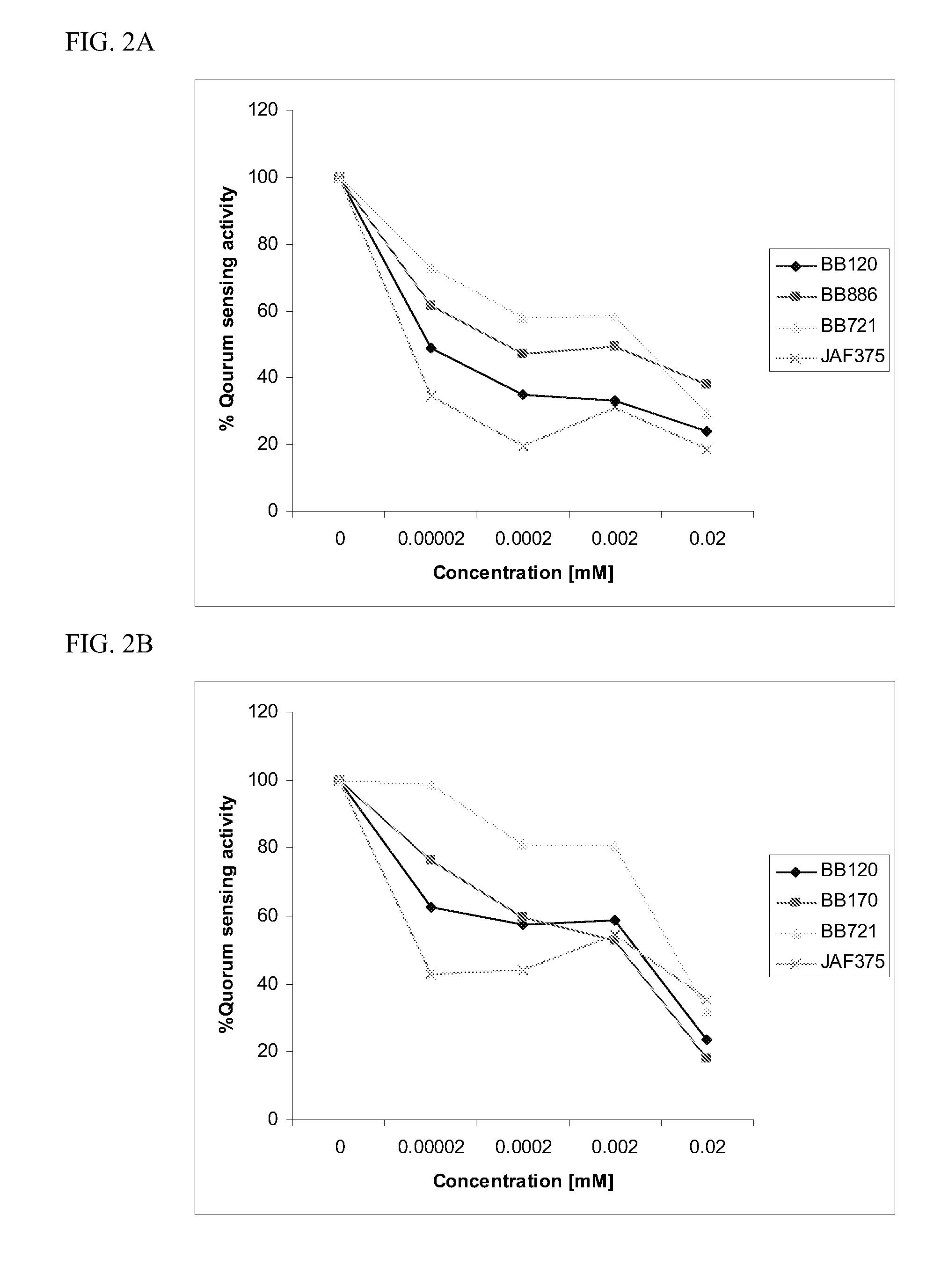Novel Anti-biofilm agents
- Summary
- Abstract
- Description
- Claims
- Application Information
AI Technical Summary
Benefits of technology
Problems solved by technology
Method used
Image
Examples
example 1
Material and Methods
[0290]2,4-Thiazolidinedione was obtained from Meryer Chemical and Fluka chemicals
[0291]Aldehydes were obtained from Sigma Aldrich, Alfa Aesar and SAFC
[0292]Maleimide was obtained from Sigma Aldrich and Alfa Aesar
[0293]Solvents was obtained from Biolab, J.T. Baker
[0294]Structure analyses were performed on an NMR-300 Hz by Varian.
Chemical Syntheses
[0295]The compounds below refer to a novel family of compounds according to some embodiments of the present invention, having the general Formula I:
wherein the variables in Formula I are as follows:
[0296]A is selected from the group consisting of O, S and R10;
[0297]T can be —S—, —O—, —CH2— or NR6—;
[0298]R1 can be H, alkyl, aryl, heteroaryl, alicyclic, heterocyclic or —(CH2)mCO2R7;
[0299]m is an integer equal or greater than 1;
[0300]y and w are integers, the sum of which is greater than or equal to 7;
[0301]X can be —CH2—, —CR8R9—, —O—, —S—, —NR2— or absent;
[0302]Z can be H, —CH3, —C(═O)Q, a linking moiety, a reactive group,...
example 2
Anti-Biofilm Formation Activity
[0430]Anti-Biofilm Formation Activity Assays in Bacteria
Biofilm-Formation Inhibition (Quorum Sensing Inhibition or QSI):
[0431]A series of V. harveyi strains (wild-type and mutants), marine bacteria which are used as a widely accepted model for testing quorum sensing, was used in the experiments below. In order to assure that the anti-biofilm forming agents (ABF) according to embodiments of the present invention are quorum sensing inhibitors (QSI) and substantially do not exert bactericidal activity per se, the MICs of exemplary anti-biofilm forming agents were determined as presented hereinbelow.
[0432]MIC was determined according to the CLSI, formerly NCCLS (National Committee for Clinical Laboratory Standards) recommendation for broth dilution antibacterial susceptibility test.
[0433]All the tested V. harveyi strains (adjusted to 0.5 MacFarlane standard suspension) were grown at 30° C., in the presence of the tested agent at concentrations ranging from...
example 3
Cell Harvesting
Vero Cells Detachment by ABF Agents:
[0473]The detachment of Vero cells by TZD10, an exemplary ABF agent according to the present invention, was examined following the method presented hereinbelow.
[0474]Vero cells (0.1 ml, 1.6×106 cells / ml) were plated in each well of flat 96-wells polystyrene plate (Nunc), and incubated overnight at 37° C. and 5% CO2. The cells were then incubated with various concentrations of the exemplary tested ABF agent TZD10.
[0475]At the indicated time intervals, the cells were washed and re-suspended in fresh medium. XTT (2,3-bis-(2-methoxy-4-nitro-5-sulfophenyl)-2H-tetrazolium-5-carboxanilide) analysis was performed to determine the viability of the attached cells.
[0476]FIG. 9 presents a comparative bar-graph showing the results of the Vero cells detachment assay using TZD10, an exemplary ABF agent according to the present embodiments, demonstrating the effectiveness of TZD10 to detach living cells from the cell-aggregate.
[0477]FIG. 10 present...
PUM
| Property | Measurement | Unit |
|---|---|---|
| Composition | aaaaa | aaaaa |
| Pharmaceutically acceptable | aaaaa | aaaaa |
| Antimicrobial properties | aaaaa | aaaaa |
Abstract
Description
Claims
Application Information
 Login to View More
Login to View More - R&D
- Intellectual Property
- Life Sciences
- Materials
- Tech Scout
- Unparalleled Data Quality
- Higher Quality Content
- 60% Fewer Hallucinations
Browse by: Latest US Patents, China's latest patents, Technical Efficacy Thesaurus, Application Domain, Technology Topic, Popular Technical Reports.
© 2025 PatSnap. All rights reserved.Legal|Privacy policy|Modern Slavery Act Transparency Statement|Sitemap|About US| Contact US: help@patsnap.com



